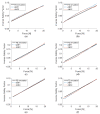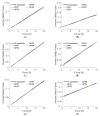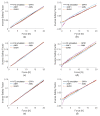Comparison of Machine Learning Algorithms for Structure State Prediction in Operational Load Monitoring
- PMID: 33321996
- PMCID: PMC7763833
- DOI: 10.3390/s20247087
Comparison of Machine Learning Algorithms for Structure State Prediction in Operational Load Monitoring
Abstract
The aim of operational load monitoring is to make predictions about the remaining usability time of structures, which is extremely useful in aerospace industry where in-service life of aircraft structural components can be maximized, taking into account safety. In order to make such predictions, strain sensors are mounted to the structure, from which data are acquired during operational time. This allows to determine how many load cycles has the structure withstood so far. Continuous monitoring of the strain distribution of the whole structure can be complicated due to vicissitude nature of the loads. Sensors should be mounted in places where stress and strain accumulations occur, and due to experiencing variable loads, the number of required sensors may be high. In this work, different machine learning and artificial intelligence algorithms are implemented to predict the current safety factor of the structure in its most stressed point, based on relatively low number of strain measurements. Adaptive neuro-fuzzy inference systems (ANFIS), support-vector machines (SVM) and Gaussian processes for machine learning (GPML) are trained with simulation data, and their effectiveness is measured using data obtained from experiments. The proposed methods are compared to the earlier work where artificial neural networks (ANN) were proven to be efficiently used for reduction of the number of sensors in operational load monitoring processes. A numerical comparison of accuracy and computational time (taking into account possible real-time applications) between all considered methods is provided.
Keywords: ANFIS; gaussian process regression; hat-stiffened panel; operational load monitoring; strain measurement; structural health monitoring; support-vector machine.
Conflict of interest statement
The author declares no conflict of interest.
Figures

















References
-
- Aldridge N., Foote P., Read I. Operational Load Monitoring for Aircraft & Maritime Applications. Strain. 2000;36:123–126. doi: 10.1111/j.1475-1305.2000.tb01187.x. - DOI
-
- Guo H., Xiao G., Mrad N., Yao J. Echelle Diffractive Grating Based Wavelength Interrogator for Potential Aerospace Applications. J. Light. Technol. 2013;31:2099–2105. doi: 10.1109/jlt.2013.2263278. - DOI
-
- Carden E.P., Fanning P. Vibration Based Condition Monitoring: A Review. Struct. Health Monit. 2004;3:355–377. doi: 10.1177/1475921704047500. - DOI
-
- Kurnyta A., Zielinski W., Reymer P., Dziendzikowski M. Operational Load Monitoring System Implementation for Su-22UM3K Aging Aircraft; Proceedings of the Structural Health Monitoring 2017 Real-Time Material State Awareness and Data-Driven Safety Assurance Proceedings of the Eleventh International Workshop on Structural Health Monitoring; Stanford, CA, USA. 12–14 September 2017.
-
- Giurgiutiu V., editor. Structural Health Monitoring of Aerospace Composites. Academic Press; Oxford, UK: 2016. Chapter 10-SHM of Fatigue Degradation and Other In-Service Damage of Aerospace Composites; pp. 395–434.
Grants and funding
LinkOut - more resources
Full Text Sources

